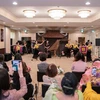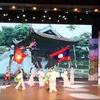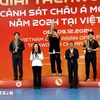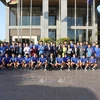 The Can Cau market is not as spacious as the markets found in Sa Pa town or Bac Ha district in Lao Cai province, but it attracts people from all over the region due to the cultural diversity of the ethnic groups residing in the border region of Si Ma Cai district. The Can Cau market is located some 80 kilometres from Lao Cai city. The market is held every Saturday, and the tents are erected only on market day. Despite its small scale, Can Cau has attracted numerous tourists because of the untouched wilderness landscape in the area and the hospitality of the local residents. (Photo: VietnamPlus)
The Can Cau market is not as spacious as the markets found in Sa Pa town or Bac Ha district in Lao Cai province, but it attracts people from all over the region due to the cultural diversity of the ethnic groups residing in the border region of Si Ma Cai district. The Can Cau market is located some 80 kilometres from Lao Cai city. The market is held every Saturday, and the tents are erected only on market day. Despite its small scale, Can Cau has attracted numerous tourists because of the untouched wilderness landscape in the area and the hospitality of the local residents. (Photo: VietnamPlus)  Can Cau is a market of Mong Hoa and Giay ethnic minority groups but they follow the business style of the Dao people. No one knows exactly the time when the Can Cau market was established, but some people said that it was initially formed after the Vietnam-China Border War in 1979 ended. The market has not been commercialised or modernised, and it has maintained the traditional lifestyle of local residents. Over an area of more than 1 hectare, all kinds of goods are displayed in their most fresh and wholesome conditions. The market has become an indispensable part of the life of ethnic minorities in Si Ma Cai district. (Photo: VietnamPlus)
Can Cau is a market of Mong Hoa and Giay ethnic minority groups but they follow the business style of the Dao people. No one knows exactly the time when the Can Cau market was established, but some people said that it was initially formed after the Vietnam-China Border War in 1979 ended. The market has not been commercialised or modernised, and it has maintained the traditional lifestyle of local residents. Over an area of more than 1 hectare, all kinds of goods are displayed in their most fresh and wholesome conditions. The market has become an indispensable part of the life of ethnic minorities in Si Ma Cai district. (Photo: VietnamPlus)  In the not so bright light of the early morning, it is not only the colorful market and local residents but also the beautiful natural surroundings that make the trip unforgettable, especially for nature lovers and photo hunters. The Can Cau market is the place for people of different minority groups in colorful dresses to exchange local items. Visitors should spend the whole morning there, and then go to Bac Ha for lunch. Visits to nearby villages and old castles are also highlights of the trip. The market will only open until late afternoon, so visitors should remember to check their itinerary or tour schedule before departing. (Photo: VietnamPlus)
In the not so bright light of the early morning, it is not only the colorful market and local residents but also the beautiful natural surroundings that make the trip unforgettable, especially for nature lovers and photo hunters. The Can Cau market is the place for people of different minority groups in colorful dresses to exchange local items. Visitors should spend the whole morning there, and then go to Bac Ha for lunch. Visits to nearby villages and old castles are also highlights of the trip. The market will only open until late afternoon, so visitors should remember to check their itinerary or tour schedule before departing. (Photo: VietnamPlus)  The Can Cau market sells different items, from vegetables, herbs and spices, to household appliances, but an interesting section is the nook where cattle, mainly buffalo, are sold. This is a bustling spot as the buffalos are brought by people from all over the region to be sold to traders from other provinces. The local residents often use cattle for farming, so the animals for sale must be the strongest ones. The atmosphere in this area is always bustling. Buyers and sellers stand along the road to negotiate on prices. After reaching agreement, both the seller and the buyer invite each other to share some food. (Photo: VietnamPlus)
The Can Cau market sells different items, from vegetables, herbs and spices, to household appliances, but an interesting section is the nook where cattle, mainly buffalo, are sold. This is a bustling spot as the buffalos are brought by people from all over the region to be sold to traders from other provinces. The local residents often use cattle for farming, so the animals for sale must be the strongest ones. The atmosphere in this area is always bustling. Buyers and sellers stand along the road to negotiate on prices. After reaching agreement, both the seller and the buyer invite each other to share some food. (Photo: VietnamPlus) Another busy and interesting section of the Can Cau market, which also attracts many visitors, is the cuisine area. This is where residents from remote villages meet and enjoy “Thang Co” together. Thang Co is a traditional dish of the Mong ethnic people, using horse meat and viscera flavoured with local spices. Today, viscera of other animals such as goats or cows can also be used. To enjoy “Thang Co” like a local, the dish should be washed down with a glass or two of corn alcohol. Many visitors stop by to try a bowl of hot horse meat, fragrant with lemon leaves, and horse bone broth, or sip a cup of corn wine and enjoy the vibrant atmosphere of the market. (Photo: VietnamPlus)
Another busy and interesting section of the Can Cau market, which also attracts many visitors, is the cuisine area. This is where residents from remote villages meet and enjoy “Thang Co” together. Thang Co is a traditional dish of the Mong ethnic people, using horse meat and viscera flavoured with local spices. Today, viscera of other animals such as goats or cows can also be used. To enjoy “Thang Co” like a local, the dish should be washed down with a glass or two of corn alcohol. Many visitors stop by to try a bowl of hot horse meat, fragrant with lemon leaves, and horse bone broth, or sip a cup of corn wine and enjoy the vibrant atmosphere of the market. (Photo: VietnamPlus)  Can Cau market gives visitors a chance to get a look into the daily life of ethnic communities in the region, as well as the unique cultural value of local ethnic groups. Besides trading, the market is also a place for young people to meet and make friends. "Given its unique culture, the Can Cau market is not only a major attraction for the locals, but also visitors from other parts of the country, who are lured by the vibrant colours of the traditional costumes of the Mong women, the brocade stalls, and especially the delicious aroma of the local cuisine," said Nguyen Tuyet Nhung, a tourist from Hanoi. (Photo: VietnamPlus)
Can Cau market gives visitors a chance to get a look into the daily life of ethnic communities in the region, as well as the unique cultural value of local ethnic groups. Besides trading, the market is also a place for young people to meet and make friends. "Given its unique culture, the Can Cau market is not only a major attraction for the locals, but also visitors from other parts of the country, who are lured by the vibrant colours of the traditional costumes of the Mong women, the brocade stalls, and especially the delicious aroma of the local cuisine," said Nguyen Tuyet Nhung, a tourist from Hanoi. (Photo: VietnamPlus)  As early as dawn, the Can Cau market is already packed with sellers and buyers. Escaping from the hustling and bustling atmosphere of the noisy urban life, tourists go to the Can Cau market to look for the pure and pristine beauty, to immerse in the idyllic activities of local people. On sales at the fair are various agricultural products, such as cucumbers, peppers and onions, along with many kinds of farming tools, such as knives and hoes – products that are simple, but have immense practical use in the life of local residents. The market is part of the unique cultural values of Lao Cai and helps promote Lao Cai tourism to international friends. (Photo: VietnamPlus)
As early as dawn, the Can Cau market is already packed with sellers and buyers. Escaping from the hustling and bustling atmosphere of the noisy urban life, tourists go to the Can Cau market to look for the pure and pristine beauty, to immerse in the idyllic activities of local people. On sales at the fair are various agricultural products, such as cucumbers, peppers and onions, along with many kinds of farming tools, such as knives and hoes – products that are simple, but have immense practical use in the life of local residents. The market is part of the unique cultural values of Lao Cai and helps promote Lao Cai tourism to international friends. (Photo: VietnamPlus)  Can Cau market does not meet every day. It is only held on Saturdays, and lasts from early morning to after noon. The market also meets on the occasion of festivals. It has been integrated in tours to a famous tourist destination of Lao Cai - Sa Pa, which is a National Tourism Site. The market is part of the unique cultural values of Lao Cai and helps attract visitors to Lao Cai. Located in the northwestern mountainous region, Lao Cai province borders Ha Giang province to the east, Son La and Lai Chau provinces to the west, Yen Bai province to the south and China’s Yunnan province to the north with a borderline of 203km. (Photo: VietnamPlus)
Can Cau market does not meet every day. It is only held on Saturdays, and lasts from early morning to after noon. The market also meets on the occasion of festivals. It has been integrated in tours to a famous tourist destination of Lao Cai - Sa Pa, which is a National Tourism Site. The market is part of the unique cultural values of Lao Cai and helps attract visitors to Lao Cai. Located in the northwestern mountainous region, Lao Cai province borders Ha Giang province to the east, Son La and Lai Chau provinces to the west, Yen Bai province to the south and China’s Yunnan province to the north with a borderline of 203km. (Photo: VietnamPlus)  On sales at the fair are various agricultural products, such as cucumbers, peppers and onions, along with many kinds of farming tools, such as knives and hoes – products that are simple, but have immense practical use in the life of local residents. Ethnic people from various corners flock here, hoping to sell their goods. Lao Cai is home to 25 ethnic groups, with the Kinh as the most populous and 24 other ethnic groups such as Hmong, Tay, Dao, Giay, Nung and Phu La. Visitors are happy to see the vibrant colours of the traditional costumes of the Mong women, the brocade stalls, and especially the delicious aroma of the local cuisine. (Photo: VietnamPlus)
On sales at the fair are various agricultural products, such as cucumbers, peppers and onions, along with many kinds of farming tools, such as knives and hoes – products that are simple, but have immense practical use in the life of local residents. Ethnic people from various corners flock here, hoping to sell their goods. Lao Cai is home to 25 ethnic groups, with the Kinh as the most populous and 24 other ethnic groups such as Hmong, Tay, Dao, Giay, Nung and Phu La. Visitors are happy to see the vibrant colours of the traditional costumes of the Mong women, the brocade stalls, and especially the delicious aroma of the local cuisine. (Photo: VietnamPlus)  Most of the goods on sales at the market are produced by local residents. One can see various locally-grown farm produce, such as cucumbers, peppers and onions. Many kinds of farming tools, such as knives and hoes, can also be found here. Those products are simple, but have immense practical use in the life of local residents. Along with Can Cau district, there are more unique highland markets in Lao Cai such as Muong Hum, Y Ty in Bat Xat district; Coc Ly, Bac Ha, Lung Phinh in Bac Ha district; and Muong Khuong, Cao Son, Pha Long, Lung Khau Nhin in Muong Khuong district. (Photo: VietnamPlus)
Most of the goods on sales at the market are produced by local residents. One can see various locally-grown farm produce, such as cucumbers, peppers and onions. Many kinds of farming tools, such as knives and hoes, can also be found here. Those products are simple, but have immense practical use in the life of local residents. Along with Can Cau district, there are more unique highland markets in Lao Cai such as Muong Hum, Y Ty in Bat Xat district; Coc Ly, Bac Ha, Lung Phinh in Bac Ha district; and Muong Khuong, Cao Son, Pha Long, Lung Khau Nhin in Muong Khuong district. (Photo: VietnamPlus)  Local ethnic people also go to Can Cau market when they need to replace essential things used in their home or farming. Lao Cai also maintains unique highland markets as Muong Hum, Y Ty in Bat Xat district; Coc Ly, Bac Ha, Lung Phinh in Bac Ha district; and Muong Khuong, Cao Son, Pha Long, Lung Khau Nhin in Muong Khuong district. The markets are not only the places for buying and selling goods but also for meeting, exchanging and dating of ethnic men and women. Home to many ethnic minority groups with specific and diversified cultural identity, Lao Cai is paying attention to developing community-based tourism to create jobs and improve the living standards for local people. (Photo: VietnamPlus)
Local ethnic people also go to Can Cau market when they need to replace essential things used in their home or farming. Lao Cai also maintains unique highland markets as Muong Hum, Y Ty in Bat Xat district; Coc Ly, Bac Ha, Lung Phinh in Bac Ha district; and Muong Khuong, Cao Son, Pha Long, Lung Khau Nhin in Muong Khuong district. The markets are not only the places for buying and selling goods but also for meeting, exchanging and dating of ethnic men and women. Home to many ethnic minority groups with specific and diversified cultural identity, Lao Cai is paying attention to developing community-based tourism to create jobs and improve the living standards for local people. (Photo: VietnamPlus)  Can Cau market appeals to visitors, including foreign tourists, because local people still keep their simple way of life and unique cultural features. The market is not only the place for buying and selling goods but also for meeting, exchanging and dating of local young men and women. Lao Cai is home to 25 ethnic groups, with the Kinh as the most populous community and 24 other ethnic groups such as Hmong, Tay, Dao, Giay, Nung and Phu La. Lao Cai is increasingly focusing on developing community-based tourism with the aim of creating jobs and improving the living standards for local people. (Photo: VietnamPlus)
Can Cau market appeals to visitors, including foreign tourists, because local people still keep their simple way of life and unique cultural features. The market is not only the place for buying and selling goods but also for meeting, exchanging and dating of local young men and women. Lao Cai is home to 25 ethnic groups, with the Kinh as the most populous community and 24 other ethnic groups such as Hmong, Tay, Dao, Giay, Nung and Phu La. Lao Cai is increasingly focusing on developing community-based tourism with the aim of creating jobs and improving the living standards for local people. (Photo: VietnamPlus)  It is not difficult for visitors to meet local ethnic men or women donning their colourful traditional costumes at Can Cau market. Local people still keep their simple way of life and unique cultural features. The market is not only the place for buying and selling goods but also for meeting, exchanging and dating of local young men and women. Can Cau market gives visitors a chance to get a look into the daily life of ethnic communities in the region, as well as the unique cultural value of local ethnic groups. It is the reason why the market attracts not only local residents but also visitors from other localities. (Photo: VietnamPlus)
It is not difficult for visitors to meet local ethnic men or women donning their colourful traditional costumes at Can Cau market. Local people still keep their simple way of life and unique cultural features. The market is not only the place for buying and selling goods but also for meeting, exchanging and dating of local young men and women. Can Cau market gives visitors a chance to get a look into the daily life of ethnic communities in the region, as well as the unique cultural value of local ethnic groups. It is the reason why the market attracts not only local residents but also visitors from other localities. (Photo: VietnamPlus)  Can Cau is one of the rare ethnic markets where traditional cultural identities of ethnic minority groups in Lao Cai province have been preserved almost intact. According to Nong Duc Ngoc, Head of the Ethnic Minority Committee of Lao Cai province, the preservation of cultural heritage is closely linked with tourism development, thus contributing to economic restructuring and sustainable poverty reduction. Ethnic cultural identity becomes a resource to promote socio-economic development of Lao Cai province. Lao Cai has a population of 674,530 (according to the 2016 statistics) and is home to Kinh (Viet) people as the most populous and 24 other ethnic groups such as Hmong, Tay, Dao, Giay, Nung and Phu La. (Photo: VietnamPlus)
Can Cau is one of the rare ethnic markets where traditional cultural identities of ethnic minority groups in Lao Cai province have been preserved almost intact. According to Nong Duc Ngoc, Head of the Ethnic Minority Committee of Lao Cai province, the preservation of cultural heritage is closely linked with tourism development, thus contributing to economic restructuring and sustainable poverty reduction. Ethnic cultural identity becomes a resource to promote socio-economic development of Lao Cai province. Lao Cai has a population of 674,530 (according to the 2016 statistics) and is home to Kinh (Viet) people as the most populous and 24 other ethnic groups such as Hmong, Tay, Dao, Giay, Nung and Phu La. (Photo: VietnamPlus)  Immersed in the bustling atmosphere at Can Cau market, visitors can feel the joy of local people, who go to the market for some relaxation after days of toiling on their fields. The markets are not only the places for buying and selling goods but also for meeting, exchanging and dating of ethnic men and women. Home to many ethnic minority groups with specific and diversified cultural identity, Lao Cai is paying attention to developing community-based tourism to create jobs and improve the living standards for local people. Besides Can Cau, there are also other highland markets in Lao Cai such as Muong Hum, Y Ty in Bat Xat district. (Photo: VietnamPlus)
Immersed in the bustling atmosphere at Can Cau market, visitors can feel the joy of local people, who go to the market for some relaxation after days of toiling on their fields. The markets are not only the places for buying and selling goods but also for meeting, exchanging and dating of ethnic men and women. Home to many ethnic minority groups with specific and diversified cultural identity, Lao Cai is paying attention to developing community-based tourism to create jobs and improve the living standards for local people. Besides Can Cau, there are also other highland markets in Lao Cai such as Muong Hum, Y Ty in Bat Xat district. (Photo: VietnamPlus)  Escaping from the hustling and bustling atmosphere of the noisy urban life, tourists go to the Can Cau market to look for the pure and pristine beauty, to immerse in the idyllic activities of local people. The market has been integrated in tours to a famous tourist destination of Lao Cai - Sa Pa, which is a National Tourism Site. The market is part of the unique cultural values of Lao Cai and helps attract visitors to Lao Cai. Located in the northwestern mountainous region, Lao Cai province borders Ha Giang province to the east, Son La and Lai Chau provinces to the west, Yen Bai province to the south and China’s Yunnan province to the north with a borderline of 203km. (Photo: VietnamPlus)
Escaping from the hustling and bustling atmosphere of the noisy urban life, tourists go to the Can Cau market to look for the pure and pristine beauty, to immerse in the idyllic activities of local people. The market has been integrated in tours to a famous tourist destination of Lao Cai - Sa Pa, which is a National Tourism Site. The market is part of the unique cultural values of Lao Cai and helps attract visitors to Lao Cai. Located in the northwestern mountainous region, Lao Cai province borders Ha Giang province to the east, Son La and Lai Chau provinces to the west, Yen Bai province to the south and China’s Yunnan province to the north with a borderline of 203km. (Photo: VietnamPlus)  Ethnic cultural identity becomes a resource to promote socio-economic development of Lao Cai province. According to Nong Duc Ngoc, Head of the Ethnic Minority Committee of Lao Cai province, the preservation of cultural heritage is closely linked with tourism development, thus contributing to economic restructuring and sustainable poverty reduction. Lao Cai province has defined that preserving and promoting the value of the cultural identity of ethnic groups is one of the important goals of this locality. Lao Cai has a population of 674,530 (according to the 2016 statistics) and is home to Kinh (Viet) people as the most populous and 24 other ethnic groups such as Hmong, Tay, Dao, Giay, Nung and Phu La. (Photo: VietnamPlus)
Ethnic cultural identity becomes a resource to promote socio-economic development of Lao Cai province. According to Nong Duc Ngoc, Head of the Ethnic Minority Committee of Lao Cai province, the preservation of cultural heritage is closely linked with tourism development, thus contributing to economic restructuring and sustainable poverty reduction. Lao Cai province has defined that preserving and promoting the value of the cultural identity of ethnic groups is one of the important goals of this locality. Lao Cai has a population of 674,530 (according to the 2016 statistics) and is home to Kinh (Viet) people as the most populous and 24 other ethnic groups such as Hmong, Tay, Dao, Giay, Nung and Phu La. (Photo: VietnamPlus)  Can Cau market is part of the unique cultural values of Lao Cai and helps attract visitors to Lao Cai. Located in the northwestern mountainous region, Lao Cai province borders Ha Giang province to the east, Son La and Lai Chau provinces to the west, Yen Bai province to the south and China’s Yunnan province to the north. To escape from the hustling and bustling atmosphere of the noisy urban life, tourists go to the Can Cau market to look for the pure and pristine beauty, to immerse in the idyllic activities of local people. The market has been integrated in tours to a famous tourist destination of Lao Cai - Sa Pa, which is a National Tourism Site. (Photo: VietnamPlus)
Can Cau market is part of the unique cultural values of Lao Cai and helps attract visitors to Lao Cai. Located in the northwestern mountainous region, Lao Cai province borders Ha Giang province to the east, Son La and Lai Chau provinces to the west, Yen Bai province to the south and China’s Yunnan province to the north. To escape from the hustling and bustling atmosphere of the noisy urban life, tourists go to the Can Cau market to look for the pure and pristine beauty, to immerse in the idyllic activities of local people. The market has been integrated in tours to a famous tourist destination of Lao Cai - Sa Pa, which is a National Tourism Site. (Photo: VietnamPlus)  Lao Cai with a mild climate and unique cultural traditions of 24 ethnic groups has developed many tourist models. Lao Cai is also one of the first provinces in Vietnam to apply a community tourism development model associated with poverty reduction for ethnic minorities. Can Cau market gives visitors a chance to get a look into the daily life of ethnic communities in the region, as well as the unique cultural value of local ethnic groups. Can Cau, along with other highlands market in Lao Cai, has helped attract tourists to the province. So far, community tourism in Lao Cai has gradually affirmed its brand. (Photo: VietnamPlus)
Lao Cai with a mild climate and unique cultural traditions of 24 ethnic groups has developed many tourist models. Lao Cai is also one of the first provinces in Vietnam to apply a community tourism development model associated with poverty reduction for ethnic minorities. Can Cau market gives visitors a chance to get a look into the daily life of ethnic communities in the region, as well as the unique cultural value of local ethnic groups. Can Cau, along with other highlands market in Lao Cai, has helped attract tourists to the province. So far, community tourism in Lao Cai has gradually affirmed its brand. (Photo: VietnamPlus)  Listed among the top 10 most beautiful places in the world by theRichest, the world’s leading entertainment and lifestyle website, Lao Cai is famous for so many things, with highlands markets such as Can Cau an indispensable unique feature. Can Cau is a market of Mong Hoa and Giay ethnic minority groups but they follow the business style of the Dao people. The Can Cau market is not as spacious as the markets found in Sa Pa town or Bac Ha district in Lao Cai province, but it attracts people from all over the region due to the cultural diversity of the ethnic groups residing in the border region of Si Ma Cai district. (Photo: VietnamPlus)
Listed among the top 10 most beautiful places in the world by theRichest, the world’s leading entertainment and lifestyle website, Lao Cai is famous for so many things, with highlands markets such as Can Cau an indispensable unique feature. Can Cau is a market of Mong Hoa and Giay ethnic minority groups but they follow the business style of the Dao people. The Can Cau market is not as spacious as the markets found in Sa Pa town or Bac Ha district in Lao Cai province, but it attracts people from all over the region due to the cultural diversity of the ethnic groups residing in the border region of Si Ma Cai district. (Photo: VietnamPlus)  Can Cau market is very important for local residents. Local ethnic people go to Can Cau market when they need to replace essential things used in their home or farming. On sales at the fair are various agricultural products, such as cucumbers, peppers and onions, along with many kinds of farming tools, such as knives and hoes – products that are simple, but have immense practical use in the life of local residents. The market is re not only the places for buying and selling goods but also for meeting, exchanging and dating of ethnic men and women. The Can Cau market is the place for people of different minority groups in colorful dresses to exchange local items. (Photo: VietnamPlus)
Can Cau market is very important for local residents. Local ethnic people go to Can Cau market when they need to replace essential things used in their home or farming. On sales at the fair are various agricultural products, such as cucumbers, peppers and onions, along with many kinds of farming tools, such as knives and hoes – products that are simple, but have immense practical use in the life of local residents. The market is re not only the places for buying and selling goods but also for meeting, exchanging and dating of ethnic men and women. The Can Cau market is the place for people of different minority groups in colorful dresses to exchange local items. (Photo: VietnamPlus)  Can Cau market has not been commercialised or modernised, and it has maintained the traditional lifestyle of local residents. Over an area of more than 1 hectare, all kinds of goods are displayed in their most fresh and wholesome conditions. In the not so bright light of the early morning, it is not only the colorful market and local residents but also the beautiful natural surroundings that make the trip unforgettable, especially for nature lovers and photo hunters. Visitors should spend the whole morning there. The market will only open until late afternoon, so visitors should remember to check their itinerary or tour schedule before departing. (Photo: VietnamPlus)
Can Cau market has not been commercialised or modernised, and it has maintained the traditional lifestyle of local residents. Over an area of more than 1 hectare, all kinds of goods are displayed in their most fresh and wholesome conditions. In the not so bright light of the early morning, it is not only the colorful market and local residents but also the beautiful natural surroundings that make the trip unforgettable, especially for nature lovers and photo hunters. Visitors should spend the whole morning there. The market will only open until late afternoon, so visitors should remember to check their itinerary or tour schedule before departing. (Photo: VietnamPlus)  Can Cau is also widely known as the biggest cattle market in the north west region. The place where cattle, mainly buffalo, are sold is a bustling spot as the buffalos are brought by people from all over the region to be sold to traders from other provinces. The local residents often use cattle for farming, so the animals for sale must be the strongest ones. The atmosphere in this area is always bustling. Buyers and sellers stand along the road to negotiate on prices. After reaching agreement, both the seller and the buyer invite each other to share some food. (Photo: VietnamPlus)
Can Cau is also widely known as the biggest cattle market in the north west region. The place where cattle, mainly buffalo, are sold is a bustling spot as the buffalos are brought by people from all over the region to be sold to traders from other provinces. The local residents often use cattle for farming, so the animals for sale must be the strongest ones. The atmosphere in this area is always bustling. Buyers and sellers stand along the road to negotiate on prices. After reaching agreement, both the seller and the buyer invite each other to share some food. (Photo: VietnamPlus)  Each time the market is held, hundreds of buffalos are brought to the market by traders from all corners in the region, such as Bac Ha, Si Ma Cai, Muong Khuong and even as far as Yen Bai province. The place where cattle, mainly buffalo, are sold is one of the most bustling spots in the market. Buyers and sellers stand along the road to negotiate on prices. After reaching agreement, both the seller and the buyer invite each other to share some food, often the typical traditional dish of the Mong ethnic people – Thang Co. The dish is cooked using horse meat and animal viscera flavoured with local spices. (Photo: VietnamPlus)
Each time the market is held, hundreds of buffalos are brought to the market by traders from all corners in the region, such as Bac Ha, Si Ma Cai, Muong Khuong and even as far as Yen Bai province. The place where cattle, mainly buffalo, are sold is one of the most bustling spots in the market. Buyers and sellers stand along the road to negotiate on prices. After reaching agreement, both the seller and the buyer invite each other to share some food, often the typical traditional dish of the Mong ethnic people – Thang Co. The dish is cooked using horse meat and animal viscera flavoured with local spices. (Photo: VietnamPlus) VNA



















